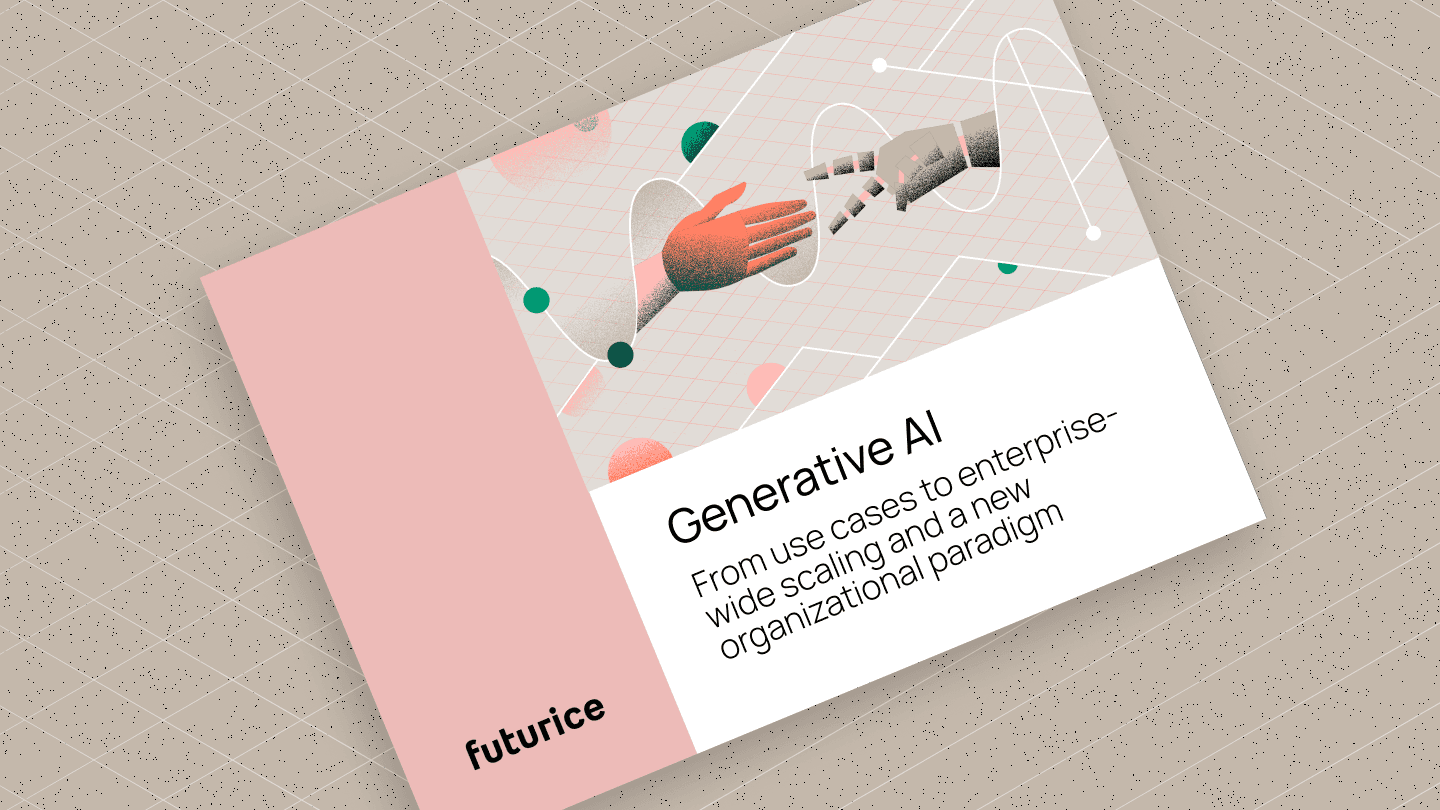How we are reinventing our work at Futurice with AI
At Futurice, we make a point of eating our own dog food and being the first guinea pigs for the actions we recommend to our clients. So, as soon as gen AI hit the world, we started experimenting with various ways we could use it in our own work. Our AI transformation is still very much a work in progress, but here are some of the key use cases we’ve been working on.

Boosting personal productivity with AI tools
The lowest-hanging fruit has been using off-the-shelf AI solutions to develop new ways to do our daily work.
This journey started from the bottom up, with people finding and adopting all sorts of tools independently. But we quickly had to organise to protect against risky behaviours, keep a handle on the costs and (most importantly) drive adoption of the things that worked.
Firstly, this meant selecting safe tools to make available centrally. For us, that included a secure implementation of GPT-4 on top of an existing in-house tool using the Azure OpenAI service. Then, we also enabled our people to access tools like ChatGPT for Teams, M365 Copilot, Github Copilot, and various built-in features and plugins in Adobe, Figma, and other design tools.
Secondly, we created multiple learning tracks to build engagement in AI and spread success stories. For example, our strategy team has a weekly data & AI session, where people share the new ways they use AI in strategy work. We have a ‘Gen AI Learning Path for Developers’, including resources, lectures & a certification program for using AI in development work. We have a mentor program where change leaders across different domains teach others how to use AI in their work. All of these are led by experts and change leaders themselves, with the support functions helping to set the stage and make their lives easy.
Dozens of high-impact individual use cases have emerged, from effectively using AI coding assistants (like Github Copilot) to using GPTs to research clients before sales meetings or quickly upskill in new project domains. We can’t quantify the overall outcome yet, but it’s clearly significant when we look at how the daily work has changed. For example, frontrunner developers report a 50%+ increase in development speed while also being able to quickly adopt new coding languages they would’ve avoided in the past.
This takes effort for sure, but it’s a low-hanging fruit that needs to be picked!
FutuCortex: Our AI-powered, automated knowledge platform
FutuCortex is a custom tool we’ve developed to help our salespeople write better proposals faster. It gives them easy access to all our past proposals, references, and thought leadership work and enables them to identify the right experts to support each case.
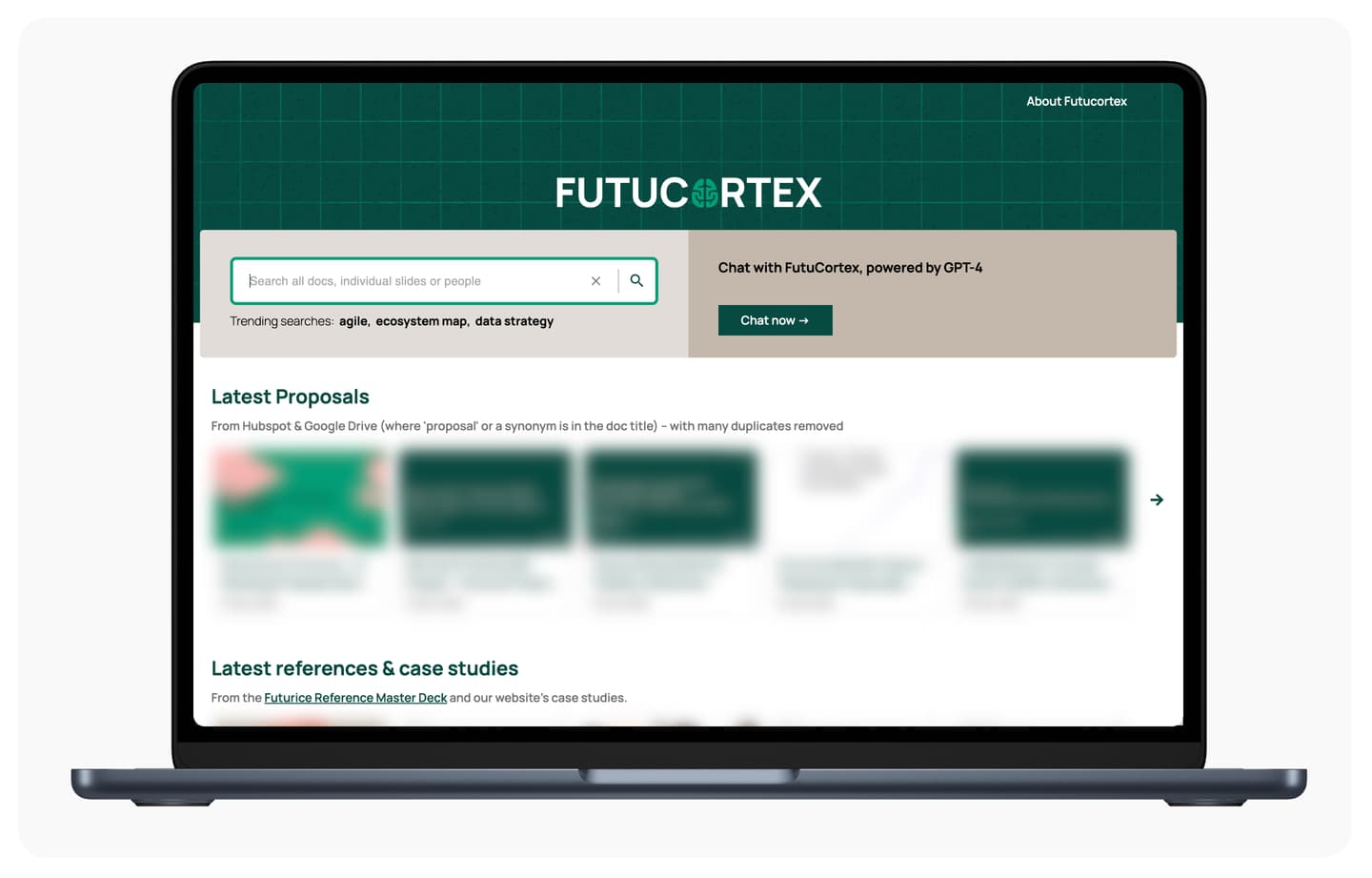
It does this by automatically extracting knowledge directly from the tools we use and the ‘digital footprint’ we create. So we have a constantly updating knowledge base without relying on lazy humans to do any manual documentation.
We’ve been working on this tool since 2020, and in early 2023, we started experimenting with how we could use gen AI to push it further. What we’ve created is a ‘retrieval augmented generation’ (RAG) solution that enables our people to use the knowledge search much more efficiently. Rather than opening a bunch of search results and manually reviewing them one by one, they can now ask natural language questions, and GPT-4 will summarise the relevant information from the search results for them (always with references to the original source, of course).
Since releasing this feature, our average unique weekly user count has more than tripled. This now includes almost all our salespeople and many others who are hacking new use cases beyond sales — which is pretty nice!
Alternative data insights for strategy
As well as directly improving our sales process, Futucortex gave us some high-quality data assets: proposals, thought leadership materials, and data on people’s interests from their public ‘digital footprint’. These assets have fuelled new use cases in our strategy process.
We call these sorts of sources 'alternative data’ — in other words, not the traditional financial reports and operational KPIs that enterprises use to drive their decisions. Alternative data typically gives a fuzzier but more leading and granular picture of what’s really happening. When used in combination with the more lagging ground truths from the financial and operational numbers, it can give us a whole lot of new insight.
For example, one part of our strategy in 2023 was to focus on creating measurable outcomes for our clients rather than just ‘deliverables’. That change started with our salespeople, who needed to sell more ‘outcome-focused’ stuff. So, to track the progress of this goal, we analysed our proposals for outcome-focused terminology. This enabled us to follow the frontline action every week, long before lagging indicators could tell us anything. Around this analysis, we then created an OKR, a process for proactively following up on underperforming proposals and an internal newsletter (“Love my Tender”) to celebrate the best examples of the strategy in action.
We’ve also been building a collection of external ‘alternative data’ assets: news data, patent data, open job position data, capital market days, social media, public tenders and so on. These give us a leading and granular picture of what’s happening with our clients and markets, too.
For example, who a company is hiring is a good proxy for what it’s really investing in, regardless of what their marketing is hyping up. So we can analyse open job positions to see if the ‘AI talk’ of our clients’ is really backed up with ‘walk’ (i.e., hiring more AI experts).
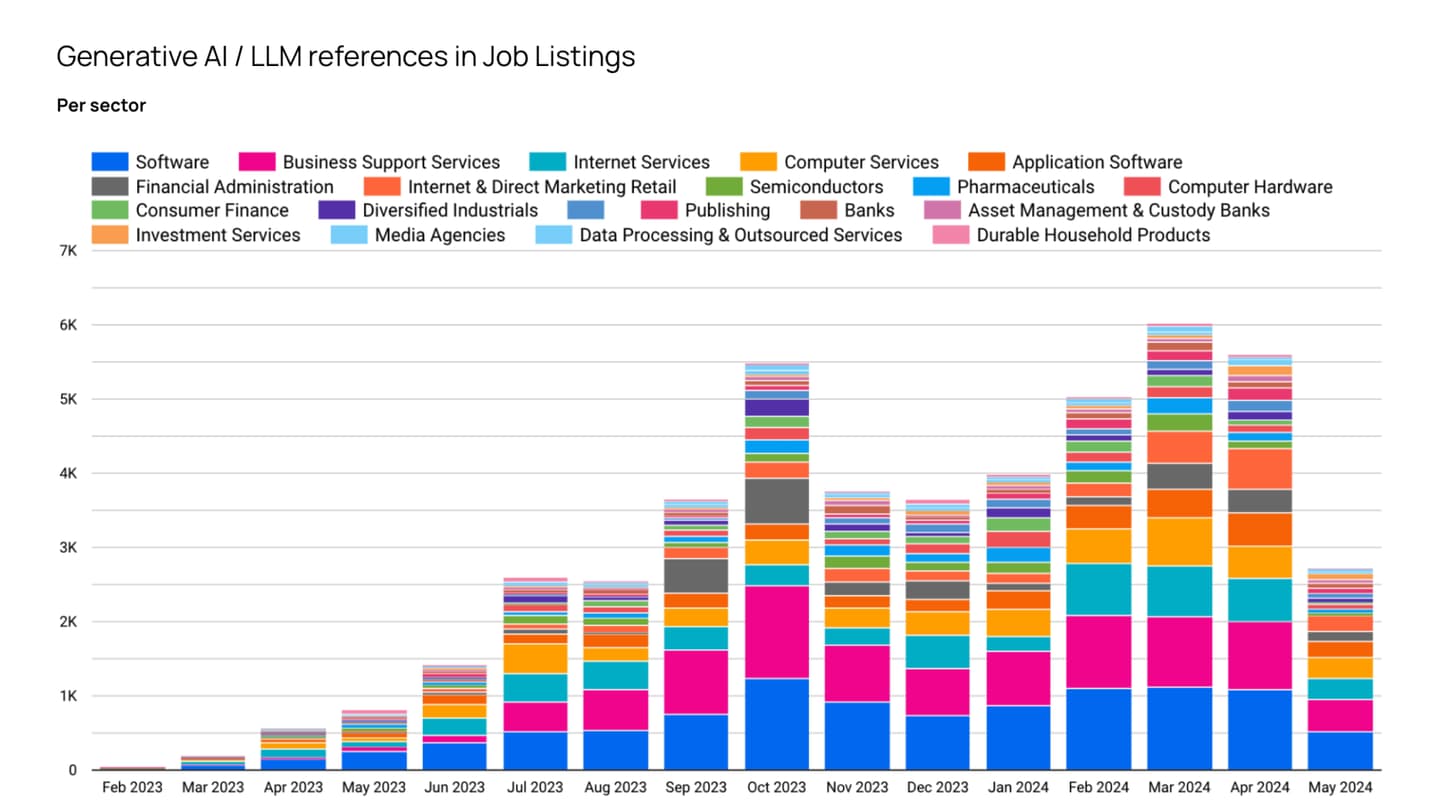
We’ve been heavily using GPT-4 to analyse these alternative data assets. We ask what data sources we should use to evaluate each question. We turn business questions into data questions by, for example, asking GPT to list the synonyms we need to search to capture a particular trend. Then we get it to run analyses for us: finding themes from large bodies of unstructured text, comparing documents, or generating & running the code needed to do numeric analysis with tools like code-interpreter.
Insights that would have taken us days or weeks to create, can now be created by non-technical people in minutes or hours. This completely changes the contexts in which we can put this data to use.
The Dog & Pony Show: Demonstrating AI success to clients
The Dog & Pony Show is our affectionate internal name for the data & AI demo show we’re continuously developing for clients — now shown to over 100 conferences, leadership teams, boards & academic institutions.
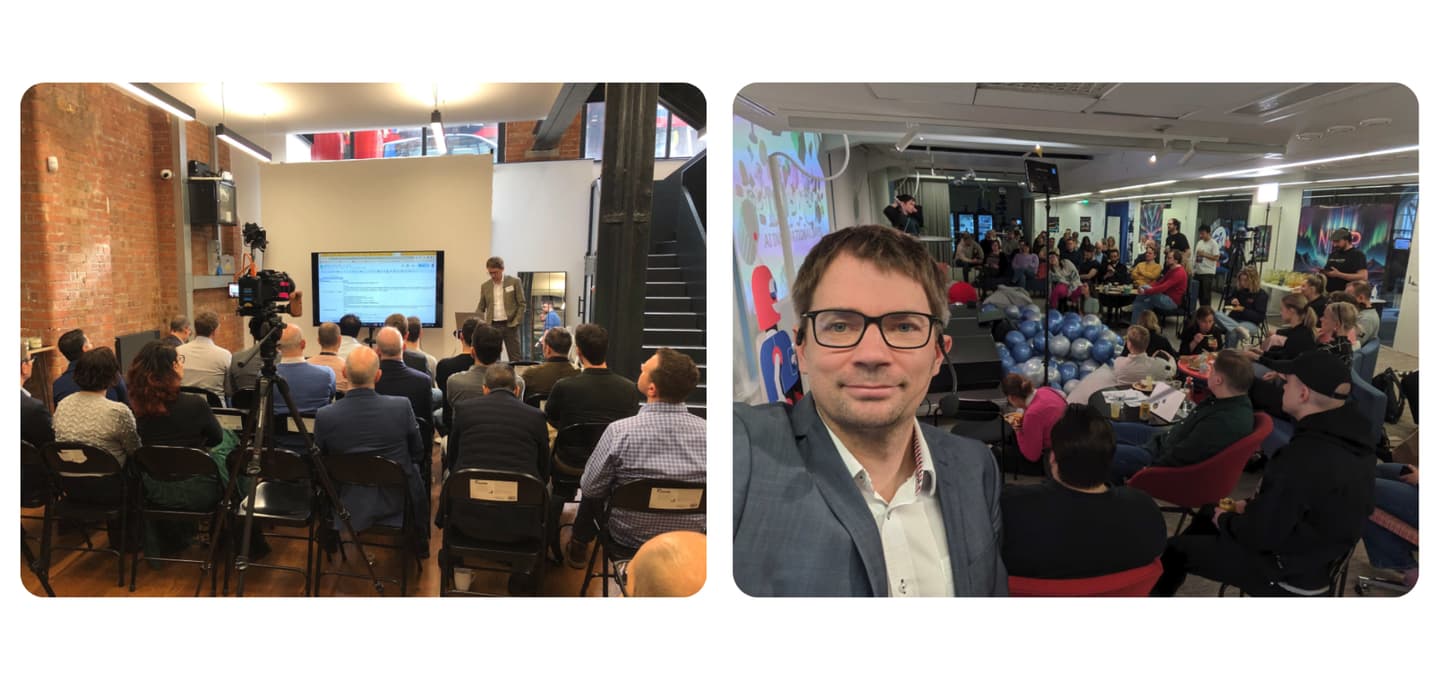
We recognized quite early that clients didn’t want to hear more high-level crap about how generative AI is going to ‘change the world.’ They really wanted to see tangible examples of how it can be used and hard-earned lessons from making it work in practice.
So, we’ve been developing live gen AI demos inspired by the internal and client projects we’ve done. We also use our alternative data assets to quickly create bespoke insights for different audiences. Neither of these things would have been practical before gen AI, as creating quality demos and insights would’ve simply been too big of an investment for unpaid sales & thought leadership work. But gen AI makes it so much faster, so we can provide more valuable content for our clients from the get-go.
Overall, the ‘show’ and the knowledge it represents has helped fuel ~500% growth in our data & AI transformation work over the last 18 months.
The next frontier: Exploring asset-based consulting with AI
Ultimately, for us, the biggest value of gen AI will be how it enables us to reinvent our offering.
Consultancy is traditionally a low gross margin and hard-to-scale business. We are primarily selling our experts’ time, which is, of course, expensive to provide. And getting more of it means hiring more consultants.
So we’re now embarking on a multi-million euro research project to establish a new ‘asset-based’ consulting offering with data & AI, supported by Business Finland and our partners. This means developing proprietary data & AI assets that enable us to execute currently manual consulting tasks much more productively — from current state/alignment/market & competitor analysis to solution design and development. Alongside these assets, we’ll create a new service and business model that charges clients for the value of our expert’s time and these scalable data & AI assets.
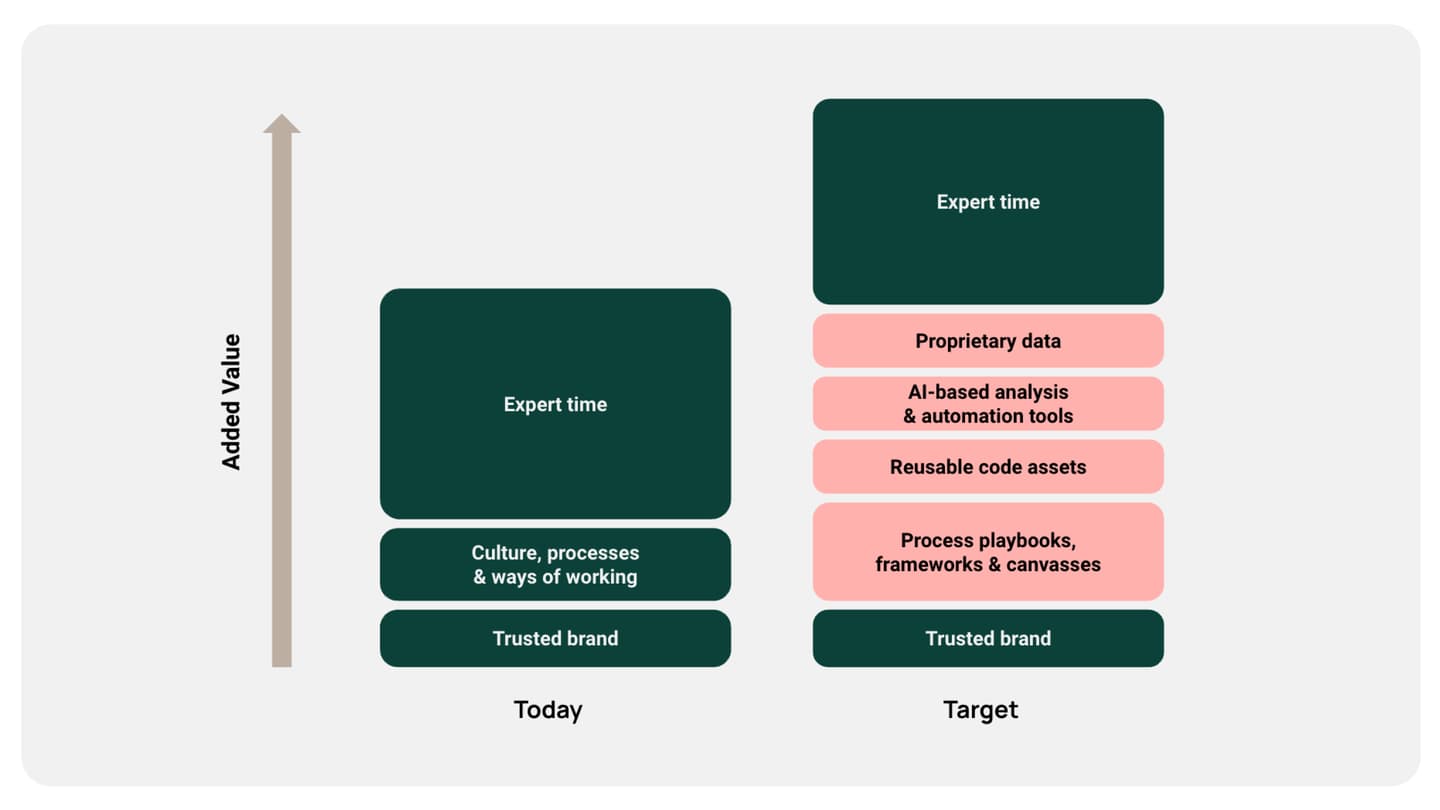
With this, we aim to create more value for clients while also generating higher gross margins and faster scaling capability for ourselves.
Looking forward
Since we released our gen AI working paper in June, our own AI transformation has continued to pick up pace. One key thing has been the amount of people driving it. In early 2023, we had one centre of excellence team carrying the flag and defining the direction. We now have four teams. And even more importantly, the mission to improve our ways of working with AI is now much more integrated into every leadership team’s agenda. We even have an OKR in H2 for every business unit to demonstrate measurable impact from gen AI in their operations by the end of the year. There’s no way this sort of global push would have worked 12 months ago because no one was ready. We hope we are ready now. But we’ll let you know for sure in five months :)
Check out the gen AI working paper to learn more about our experiences and thinking in this area. This blog post is the first in a series that revisits its best learnings, with a few updates thrown in. Or you can always just get in touch with me.
 Jack RichardsonHead of Data & AI Transformation
Jack RichardsonHead of Data & AI Transformation



